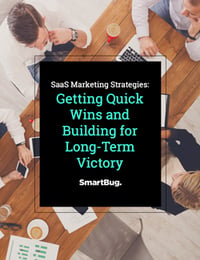
3 Reasons Your Customer Acquisition Cost Is Too High (and How to Lower It)
September 2, 2020
By Joe Brannen
Congratulations! Your SaaS solution is starting to take off and the leads are starting to flow! But before you pop the champagne, there’s one metric you may not have considered: customer acquisition cost (CAC). Leads don’t just magically appear—time, budget, and effort went into securing leads, and it’s important to factor in this cost before calling a campaign a success. What steps can you take to understand CAC and how can you lower it?
Breaking Down Customer Acquisition Cost
Tools such as Google Analytics can give you a quick glance at CAC, but know that there is more to it than what Google can see. The basic formula is:
CAC = Sales and Marketing Cost/Number of New Customers
To accurately calculate this, you need to get pretty granular. It’s not only the cost of keywords, the amount of swag sent, or the mileage that sales logged to do an on-site visit. SaaS businesses must account for every minute detail, such as:
- Sales and marketing salaries
- Cost of technology
- Campaign budgets
- If it is a paid campaign, the cost per click (CPC) and total ad spend
- If it is an event like a trade show or a webinar, sponsor fees and presenter costs
Although it may not be necessary to account for the absolute total sales and marketing cost (you can hold off on finding out how much the department spent on staplers), it’s important to account for all the costs that could have had a significant impact. HubSpot did a pretty in-depth dive into expansion SaaS benchmarks back in 2019 that may be helpful deciding which you’d like to include in your formula.
If you’re here, you’ve likely crunched the numbers and are a bit unhappy with your CAC. Here are a few problems that may lead to a high CAC:
Issue #1: Improper Targeting
Many successes and failures in marketing originate from personas. If you’ve not yet created your buyer personas, doing so is your first step. An ironclad buyer persona can help you better focus on the best keywords or craft the best messaging to help you reach your target audience faster and quickly close deals. If you have created buyer personas, take a look at a few completed campaigns and perform a post-mortem to evaluate their success. If you find that these campaigns didn’t do well, here are a few things to consider:
- Were the keywords and messaging appropriate for this persona?
- What was the weakest link of the campaign? (e.g., targets dropped after a certain email or the ad campaign had a poor conversion rate)
- Were the leads properly qualified before sending to sales?
- How closely did the target audience align with the persona?
- Was there an emphasis on lead quantity over lead quality?
Solidifying your targeting and campaigns leads to a higher success rate and, ultimately, to more conversions. This boosts the important bottom portion of our customer acquisition cost formula.
Issue #2: Too Little/Too Many Campaign Steps
Once your target audience is in a good place, it’s time to look at the contents of the campaign. Many marketers make the mistake of including too few campaign steps in an effort to try to get the leads to close faster. This could mean suggesting a demo request to a lead too soon or, as we mentioned above, passing off the lead to sales before the lead is ready.
But the old saying “too much of a good thing” could be at play here as well. If you have too much content and too many steps in a campaign, the lead could lose interest or be so inundated with content that they tune you out. Or the lead might have actually converted earlier in the campaign so the amount of campaign content drives up CAC. It’s important to find that happy medium and create successful strategies to ensure qualified leads are ready to buy. If you need some inspiration, HubSpot comes to the rescue again with its poll of marketers’ favorite 2019 campaigns.
(How customer acquisition cost comes into play with paid media campaigns is a whole other ball game, but my colleague covers the subject quite nicely here.)
Issue #3: Too Much Human Interaction
Although personalization and knowing your audience is important, it doesn’t necessarily need to be done by a human. Remember, more people in the mix means sales and marketing personnel are spending more time on lead conversion in a single campaign when they could be focusing their energies on making new campaigns and securing more leads. But well-developed automation can help lower CAC.
Automation isn’t just one email triggering another. Elements such as personalization tokens and dynamic or smart content can give an automatic or templated email a more personal touch and/or deliver the most meaningful content to the lead. Setting up a clever automated email campaign with the right amount of personalization means you’ll spend less time crafting personal emails. And why stop there? Setting up dynamic content on your website can mean your leads will see relevant content after visiting a product page or they’ll simply never see the same content twice.
Recognizing Value Beyond the First Sale
Although we started this article with the simple question of “how do you lower CAC?” it’s important to realize that your customer can be valuable beyond a closed sale. A happy customer offers opportunities for upselling, meaning even more revenue can be generated from the secured lead. Your customer could also help spread the word and secure new customers. Never underestimate or neglect the delight stage of the customer journey.
Although lowering CAC isn’t an easy task, having a solid strategy in place goes a long way toward making the most of your efforts and closing more leads—both of which will help lower customer acquisition cost.

About the author
Joe Brannen was formerly an Inbound Marketing Specialist at SmartBug Media. He is fascinated with all things digital marketing and uses this to help clients implement inbound marketing strategies to reach their goals. Read more articles by Joe Brannen.









